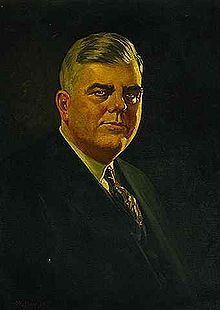Role American Politician Succeeded by Dewey Johnson | Preceded by J. A. O. Preus Name Theodore Christianson | |
 | ||
Lieutenant William I. NolanCharles E. Adams Born September 12, 1883Lac qui Parle Township, Minnesota ( 1883-09-12 ) Alma mater University of MinnesotaUniversity of Minnesota Law School Spouse Mayme Bundy (m. 1946), Ruth Donaldson (m. 1907), Emily Walker Books Minnesota: The Land of Sky-tinted Waters : a History of the State and Its People Education University of Minnesota Law School, University of Minnesota | ||
Theodore Christianson (September 12, 1883 – December 9, 1948) was an American politician who served as the 21st Governor of Minnesota from January 6, 1925, until January 6, 1931.
Contents
Early life
Christianson was born in Lac qui Parle Township, Minnesota. He was of Norwegian descent. He attended Dawson High School. He graduated from the University of Minnesota, Arts College in 1906. Christianson graduated from the University of Minnesota Law School in 1909. He was admitted to the Minnesota State Bar in 1909. Before entering politics, Christianson had pursued dual careers in western Minnesota, where he both practiced law and was editor and publisher of the Dawson Sentinel for fifteen years. Five consecutive terms as a Republican state legislator convinced him that government reorganization was in order.
Career
"More Ted, Less Taxes" was the campaign promise of Theodore Christianson when he ran for governor in 1924. "Tightwad Ted," as he was affectionately dubbed, kept his word. During his administration, he limited taxes and cut expenditures at every level of state government. Voters—in a conservative mood after the turmoil of World War I—expressed their approval of his cautious fiscal policy and his disdain for socialism by re-electing him twice.
Efficiency was as crucial as thrift to Minnesota's twenty-first governor and he incorporated both priorities in his 1925 Reorganization Act. To firm up a flabby bureaucracy, he appointed a three-man Commission of Administration and Finance. This so-called "Big Three" unleashed the veto power of the chief executive, who slashed budget appropriations he considered extravagant.
Christianson's bid for nomination to the U.S. Senate in 1930 failed as he lost the Republican nomination to incumbent Thomas Schall, and he left politics temporarily. During a three-year hiatus, the former newspaperman continued to serve his native state by writing its history, a five-volume work The Land of Sky-Tinted Waters: A History of the State and its People (Minnesota: 1935). He rounded out his public career with two terms in Congress. In 1936, he did not run for re-election to the House; instead he ran for Senate again. Receiving the Republican nomination, he ran against former Congressman Ernest Lundeen of the Farmer Labor Party and was defeated, receiving 37% of the vote.
Later life
After leaving politics, Christianson moved to Chicago and served as secretary-manager of the National Association of Retail Grocers from 1937 to 1939. He was public relations counsel for the National Association of Retail Druggists from 1938 to 1945, and editor of the National Association of Retail Druggists Journal from 1945 to 1948.
Family
His son was Theodore Christianson who served on the Minnesota Supreme Court.
Death
Christianson had recently retired to Dawson, Minnesota, when he died of a heart attack at 65 years of age. He is interred at Sunset Memorial Park Cemetery in Minneapolis, Minnesota.
